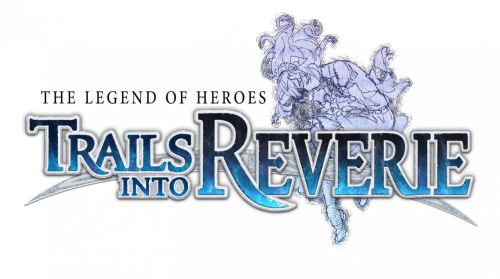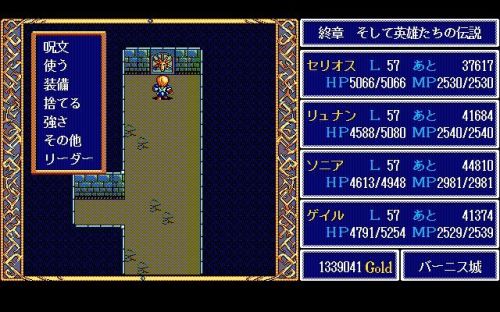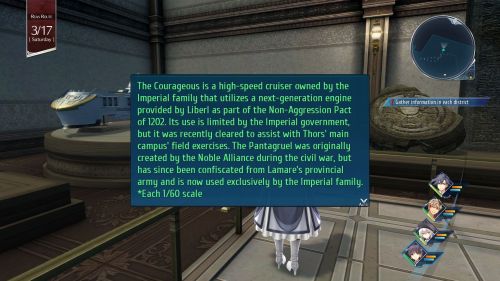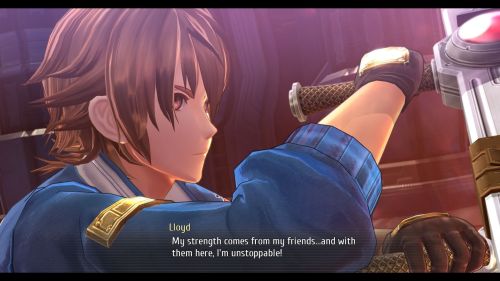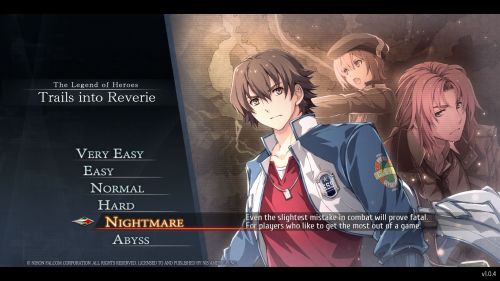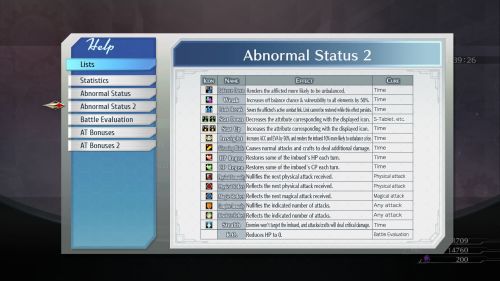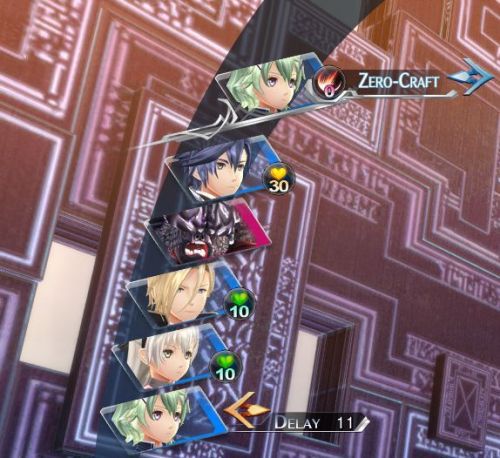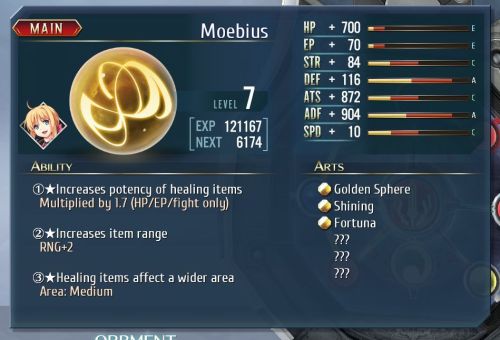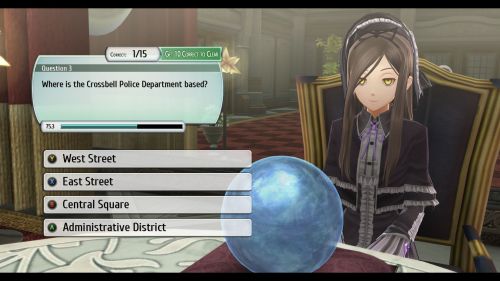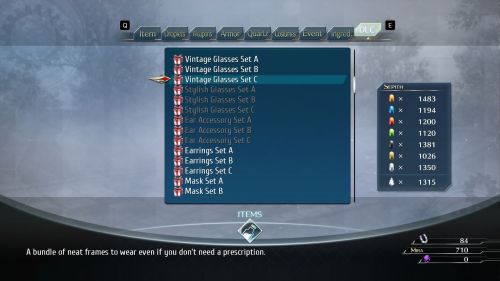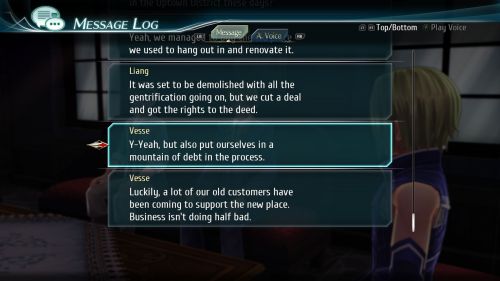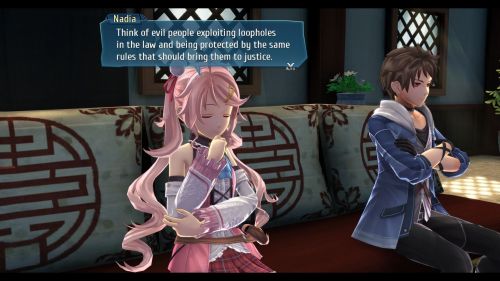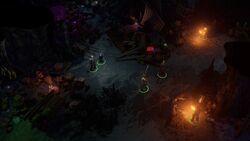JRPG Codex Review: The Legend of Heroes: Trails into Reverie
JRPG Codex Review: The Legend of Heroes: Trails into Reverie
Review - posted by Darth Roxor on Mon 14 August 2023, 12:27:01
Tags: Falcom; The Legend of Heroes: Trails into ReverieEvery now and again, some degenerate can't help but tell the entire world about his uncommon fetishes, and so he sends us a review of a JRPG. This time, it would be community member Rean, who has delighted us with his wall of text about The Legend of Heroes: Trails into Reverie.
Suffice to say, he seems to be fairly positive about it. To give a snippet:
The article is fairly in-depth, and many of the details mentioned here managed to spark the interest of even someone as jaded as yours truly. To find out if you are also able to connect with your inner weeb, dive right on in. Read the full article: JRPG Codex Review: The Legend of Heroes: Trails into Reverie
Suffice to say, he seems to be fairly positive about it. To give a snippet:
Since Trails in the Sky came out, the series' strongest point has always been its capability for immersion in the world. The reviews of the series starting in 2004 have traditionally mentioned the astonishing attention to detail, with reviewers being impressed by the fact that each character had their own name, background origins, personality and aspirations, rather than just being "NPC #12" and "Character #24". These games truly feel alive, in ways that no other series ever has. The world of Zemuria itself never just displays happiness incarnate, but it's never pure gloom either. It's a balanced, objective world that is realistic and alive, in every meaning of the word, where every non-player character feels important and worth your time learning about and talking to. No other series has been able to achieve this level of fleshing out for its setting. And the great thing is that as events are always on the move and organic, the player is always kept on his toes. If you're a series veteran, get ready for the twists and turns of Reverie, where certain parts are once again turned on their heads!
(...)
Once again you will get to control a massive cast of characters, each one with their own personality and combat abilities. You'll meet old characters and new alike – among them, the protagonists of every past series, a political terrorist leader, a powerful villain re-emerged and even a sentient doll. The characters whose lives you will closely experience constantly struggle with their own morality and place in the world, such as the former contract killer Rixia when she encounters a duo of young assassins, and Rean, when he meets a master of both the blade and life that far surpasses his own abilities.
The characters come and go throughout the game, much like in previous entries. Don't get too attached to anyone for too long and try not to equip your absolute strongest equipment or gems on anyone but the main characters until you have plenty enough to go around; the way the game flows is entirely dependent on the plot.
And the enemies do include just everything this time as well, from dancing ant-eaters to krakens and demons, assassins, perverted versions of your own characters and more. Some of the creatures are throwbacks to Trails in the Sky from 19 years ago, others are brand new. Regardless, figuring out and exploiting or working around weaknesses and resistances is as fun as ever, especially when you introduce the high difficulty tactical element.
(...)
Once again you will get to control a massive cast of characters, each one with their own personality and combat abilities. You'll meet old characters and new alike – among them, the protagonists of every past series, a political terrorist leader, a powerful villain re-emerged and even a sentient doll. The characters whose lives you will closely experience constantly struggle with their own morality and place in the world, such as the former contract killer Rixia when she encounters a duo of young assassins, and Rean, when he meets a master of both the blade and life that far surpasses his own abilities.
The characters come and go throughout the game, much like in previous entries. Don't get too attached to anyone for too long and try not to equip your absolute strongest equipment or gems on anyone but the main characters until you have plenty enough to go around; the way the game flows is entirely dependent on the plot.
And the enemies do include just everything this time as well, from dancing ant-eaters to krakens and demons, assassins, perverted versions of your own characters and more. Some of the creatures are throwbacks to Trails in the Sky from 19 years ago, others are brand new. Regardless, figuring out and exploiting or working around weaknesses and resistances is as fun as ever, especially when you introduce the high difficulty tactical element.
The article is fairly in-depth, and many of the details mentioned here managed to spark the interest of even someone as jaded as yours truly. To find out if you are also able to connect with your inner weeb, dive right on in. Read the full article: JRPG Codex Review: The Legend of Heroes: Trails into Reverie
[Review by Rean]
The Legend of Heroes: Trails into Reverie
The Legend of Heroes
It's no secret that there has been a dearth of JRPG coverage here since Crooked Bee and other old contributors stepped away.
Despite a small percentage of the RPG population thinking of Japanese RPGs as an exotic genre, JRPGs have played a formative role in the growing – up process of millions of gamers in the west: from each lengthy Final Fantasy experience, to the colorful Breath of Fire, to the wackiness of Earthbound, to the dungeons of Shining Force or to the collectathons of Pokémon (also, did you know that one of the earliest pieces of Codex content was about Grandia II?).
And what about The Legend of Heroes? Although not too many are aware these days, The Legend of Heroes, by Falcom (the company behind these games, and also behind The Legendary Ys) had its start all the way back in 1989 – it was a series of games very different to the ones of today, though. Its reinvention with 2004's The Legend of Heroes: Trails in the Sky made Falcom wildly popular in both Japan and the West. These games are so well-respected and adored on our side of the globe that people translate them for free before they receive official western releases, just so the community may get to enjoy them.
And there's much to love, starting with the games' setting. While older Japanese game series in a shared universe do exist, (such as Metal Gear) The Legend of Heroes, now officially running for 19 years, is set to make a record for the longest running one in a consistent, well – defined original setting; the world of Zemuria.
This review focuses on the latest western PC release of Trails into Reverie, part of the modern The Legend of Heroes.
The Past and the Present
Let's start off with the basics. The Legend of Heroes series is divided into five categories/settings, in order of release:
Reverie itself is a special release that serves as the end of an era, intended to bridge the gap between the past and future. For all intents and purposes, many, including myself, consider it to be a continuation of Trails of Cold Steel, as it looks and sounds the same, technically being the fifth game in the series.
The Setting
The world of The Legend of Heroes games is one where traditional fantasy and science-fiction have married and live happily together. There is no significant struggle of magic versus technology, like in other similar settings. In Zemuria, the usage of both is something that's considered quite ordinary; the populace at-large and common people have adapted to the ancient arcane arts, as well as the developments of the Orbal Revolution, one of the most defining historical events of the setting.
While Trails in the Sky was a bit more steampunk-ish, Cold Steel pushed the environment towards a more soft fantasy tone, with a remaining base of industry, religion and magic.
Despite all that, the series' main draw is undoubtedly politics, and there are very few original settings with the level of political lore and development comparable to it.
The Legend of Heroes, if you boil it down, is a very long political soap opera in an essence of fantasy.
There's an aspect of ever-looming war with mech/action elements, especially during battle, and it all serves to reinforce the base setting and plotlines. The writers of the series have obviously taken inspiration from major western historical conflicts like the European wars of succession, the Napoleonic wars and the American Revolutionary War. The underlying themes of Empires and Kingdoms, annexations, civil war and independence have been a focal point since the beginning. These matters continue to be just as important with Reverie, the events of the independence of the Crossbell State bringing together motley groups of mages, soldiers, students, politicians and divinely blessed heroes.
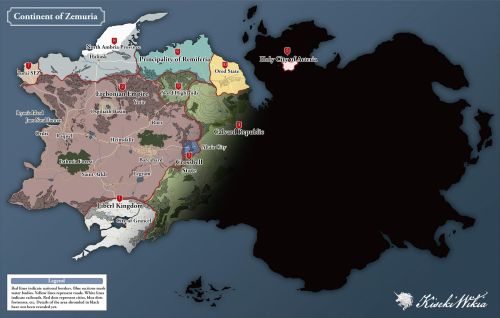
Map of Zemuria. Reverie's events play around a developing situation in Crossbell and the tensions it creates as an important center point stuck between the neighboring nations of the Erebonian Empire and the Calvard Republic. (courtesy of Kiseki Wikia)
Immersion
Since Trails in the Sky came out, the series' strongest point has always been its capability for immersion in the world. The reviews of the series starting in 2004 have traditionally mentioned the astonishing attention to detail, with reviewers being impressed by the fact that each character had their own name, background origins, personality and aspirations, rather than just being "NPC #12" and "Character #24". These games truly feel alive, in ways that no other series ever has. The world of Zemuria itself never just displays happiness incarnate, but it's never pure gloom either. It's a balanced, objective world that is realistic and alive, in every meaning of the word, where every non-player character feels important and worth your time learning about and talking to. No other series has been able to achieve this level of fleshing out for its setting. And the great thing is that as events are always on the move and organic, the player is always kept on his toes. If you're a series veteran, get ready for the twists and turns of Reverie, where certain parts are once again turned on their heads!
While the games don't often break the fourth wall and dialogue doesn't tend to be 'gamey', some characters do say things like 'leveled up' and derivatives from time to time. It's not really a big deal, and you can consider that one of the few occurences of the game not achieving perfect in-setting immersion.
Here's another slightly more meta/background point that I often am critical of as I play narrative-heavy games: The series does well with not creating any dissonance between what the characters do during active gameplay and what they actually say and claim in cutscenes and dialogue – a disconnect that happens in various games quite often, especially of the more freeform kind. That's not to say there's branching dialogue or reactivity in cutscenes, because there isn't, but rather that the narration remains consistent with who the characters are.
Don't come to these games expecting to find Dark Souls. You are not an unnamed creature roaming the lands. You are always some form of an important character, with an existing place in the world. The mix of text, roaming and combat has been one quite specific to The Legend of Heroes series, and one they've set themselves a reliable formula for. Expect to read a lot of text, go through sequences of cutscenes and then maybe hours of long successive combat encounters or a half-hour long boss battle.
These games always call on you to be someone who makes an impact – although this is done in a more grounded rather than the Marvel superhero sense of the word. And while your characters play important roles, you're never the biggest fish in the pond in these games – just the way it should be in every self-respecting piece of fiction that showcases conflict.
Reverie
Trails into Reverie came out in Japan in 2020, but the proper western PC port was released only in early July 2023. As it stands, it's a brand new experience for most of us.
Before we get into the nitty-gritty, I want to get this out of the way and address the matters of balance briefly: there's a... good reason behind the stereotype that the Japanese don't know how to balance games and this franchise reinforces that notion, at times. The Legend of Heroes games have never been particularly difficult, with the exception of Trails in the Sky 3rd, which has been known to be a pain in the rear at times. The first Cold Steel could also be decently challenging occasionally at high difficulties, but only if you compare it with the sequels, which ended up being quite forgiving. These games will not always provide a hardcore combat experience unless you push them to the absolute highest difficulties – and that might occasionally rob you of the joy of experimentation they offer. I'll be providing some more input on this further on.
Trails of Cold Steel, which Reverie is built on, has been traditionally viewed as a relatively easy series when it comes to combat; and that was not because the monsters didn't hit hard enough or because of overwhelmingly powerful player character abilities, but rather due to the gradual introduction of more and more combat tools, such as Brave Orders, power-creep equipment upgrades, dual quartz etc. Cold Steel IV turned out to be the easiest game in the whole franchise due to just how many options and characters they ended up making available to the player, and Falcom not having balanced appropriately around those at even the highest difficulties. In the case of this series, continuously opening up new options for the player made combat significantly easier!
But read on to know more about the improvements Reverie has made in this regard, because they are thankfully present...
Let's get one thing out of the way for those who have played games in the series previously: Trails into Reverie does not reinvent the wheel – but it does do a whole bunch of things better than its predecessors.
What can Reverie provide to a series veteran and can it be a good starting point for a newcomer?
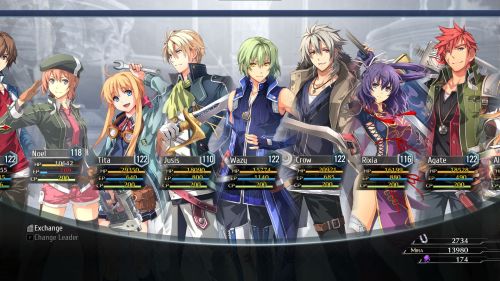
The game is a farewell ode to many of the heroes we've come to know and love over the past two decades.
The game itself is split into 3 arcs, each one centered on different protagonists and their respective groups.
Out of the three main characters:
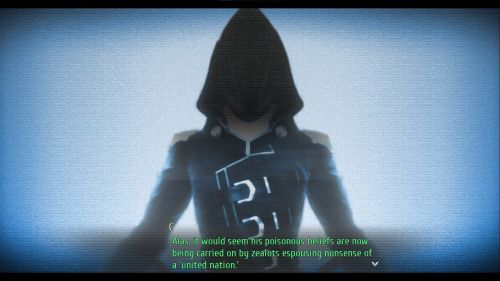
C is edgy.

I'll take your mind off disastrous politics and a bad economy by introducing you to them in a new setting.
Rean and Lloyd both have their fans and detractors online. Considering the franchise started with old favorite Estelle throughout the 3 Trails in the Sky games, continued on with Lloyd through 2 Crossbell games and then Rean with the 4 Trails of Cold Steel games, it's fairly obvious that Rean has ended up receiving the most character development.
That being said, there's an important point that needs to be made. These games were never about the main characters, and anyone who tells you they are is simply wrong, ill-informed or a liar. Each one of the MCs has remained heavily grounded throughout the franchise and is only slightly relevant when it comes to the true grand tales: the one of the land, the one of bonds being forged, the one of the past influencing a future. The importance of each arc is highlighted via every controlled character and their presented struggles against a shared goal, while the MC leads the way forward and serves as a central point to bring all those different personalities together.
In Reverie, you will go from saving children to preventing apocalypses. Don't expect to find something grimdark like in King Arthur: Knight's Tale here. This is a colorful game, although not necessarily too cheery once you begin exploring what truly lies under the surface. The foes that await you are once again countless and, thankfully, memorable. You'll see the return of old villains and meet new ones.
Like every game throughout this franchise, the focus isn't simply on the heroics and the grand achievements. There are many day-to-day life and behind-the-scenes elements spread throughout, the spotlight occasionally shining on activities that highlight the massive effort behind the annexation of a country or the desires of the common soldier. The action and core tension is maintained by those critical principles being present, like in any good, long drama series.
As in many anime and JRPGs, Reverie has its ups and downs and there are even some deus-ex-machina moments that might make you question matters; I do too, occasionally. Regardless, the instances are not too many and the story remains for the most part fairly grounded, as it should be.
The game is different from other previous core entries in the sense that tension is maintained throughout the whole deal. Mostly everything that happens is linked to the main plot and conflict, meaning that familiar past "slice-of-life" content is limited, and largely only accessible through the Reverie Corridor.
The Core of Reverie
Once again you will get to control a massive cast of characters, each one with their own personality and combat abilities. You'll meet old characters and new alike – among them, the protagonists of every past series, a political terrorist leader, a powerful villain re-emerged and even a sentient doll. The characters whose lives you will closely experience constantly struggle with their own morality and place in the world, such as the former contract killer Rixia when she encounters a duo of young assassins, and Rean, when he meets a master of both the blade and life that far surpasses his own abilities.
The characters come and go throughout the game, much like in previous entries. Don't get too attached to anyone for too long and try not to equip your absolute strongest equipment or gems on anyone but the main characters until you have plenty enough to go around; the way the game flows is entirely dependent on the plot.
And the enemies do include just everything this time as well, from dancing ant-eaters to krakens and demons, assassins, perverted versions of your own characters and more. Some of the creatures are throwbacks to Trails in the Sky from 19 years ago, others are brand new. Regardless, figuring out and exploiting or working around weaknesses and resistances is as fun as ever, especially when you introduce the high difficulty tactical element.
Combat itself consists of a turn-based JRPG system reminiscent of older Final Fantasy games, with a focus on extravagant, cool visual effects.
Once again, using an S-Craft which allows you to turn the tide of battle and annihilate your enemies is an incomparable power trip. Pathfinder can't do this.
That being said, it's important to highlight the following: once you start the game, choose Nightmare difficulty and never go below it. All points in this review assume Nightmare difficulty and above. Would it have been nice for Normal difficulty to be more appropriate? Yeah – but this is a Japanese game! The high difficulties are still not perfect, especially when it comes to... you guessed it, the bosses! Expect to get absolutely pounded by certain big bosses damage-wise, who will also often hijack your actions (much like the player can do with S-Crafts, heh). But who doesn't like a bit of challenge every now and then?
You can also go for Abyss, but then you'll be starting to move into absolute build optimization territory and maybe even be forced to grind; if that's what you're into, go for it. Abyss is probably decent for a New Game+ run, providing a challenge that we haven't seen in the franchise in a very long time.
Once again, taking heed of your enemies' strength and weaknesses by examining their stats is vital to quick and painless victories.
Reverie utilizes all the new tools you have in your arsenal to a satisfying extent, granting you unparalleled freedom in how you want to achieve victory in battle. Equipping your characters with different setups is a joy – with access to the most quartz the series has ever provided, the tactical choices open up vastly, allowing you to try anything from pure magic to full evasion on any one character.
Itemization is a multi-pronged deal and mostly dependent on what stats you're aiming for.
The character combinations and party mix-ups you can try allow for quite a bit of experimentation. This all comes together in ideal fashion in the Reverie Corridor (more on this later).
You can, as in many modern JRPGs, approach the enemy on the field and strike them from the back to make the initial leg of your fight easier, or link up multiple groups of enemies together to fight them in a chain battle for bigger rewards. You may also consume an Assault Gauge charge to stun your enemy on the field and gain what is called a Triple Advantage, which makes it easier to break them when the fight starts. In the same manner, if you fail to dodge your enemy while running around on the field and they attack you from the back, they'll gain the advantage on you, as well as scramble your formation and Combat Links. The whole system also serves to keep the grinding at bay, as it allows you to instantly destroy enemies you massively outlevel without wasting time fighting them, while still getting the rewards.
Those aformentioned systems were already fully present in the latter two of past Trails of Cold Steel games, but there's now a new additional, in-battle use for the Assault Gauge: an action called United Front, which presents three additional choices.
Seeing as Reverie promotes characters to some very high levels, expect to see quartz and stat upgrades quite early; for example, Rean's starting Brigid, providing you massive amounts of CP (Craft Points) regeneration, or the Titania quartz, which actually gives you EP (Energy Points) when you use arts so you can use MORE arts. Of course, you can swap around most of those between characters – even between arcs after you've progressed a while. For those who can't handle the feeling of weakness their characters are infected with after starting a sequel, I can safely say you won't have to suffer for more than maybe 10-15 levels – and thankfully, you get to see a whole bunch of new abilities as well, so it's not just about striving to get to your previous Trails of Cold Steel IV power levels.
Reverie once again utilizes the Action Time Battle system that's been in use since Trails in the Sky. The most important, by far, tactical aspect of higher-difficulty combat is the battle/action order (call it initiative or whatever you want, it's similar enough). Some turns will elicit special effects, giving you instant-cast magic arts or letting you inflict a guaranteed status effect etc or even having a negative effect, like draining your EP. Watch that action bar like a hawk, and as competitive gamers say, PRAY FOR CRITS (and be sure to steal your opponents' criticals with S-Crafts).
Given that we play on Nightmare and above, positioning is a much more serious matter. Regardless of how hard your characters may hit, the enemies will usually hit harder on Nightmare and over. You need to spread out enough to avoid AOE abilities, but not too much so that you cannot AOE heal your people, if possible.
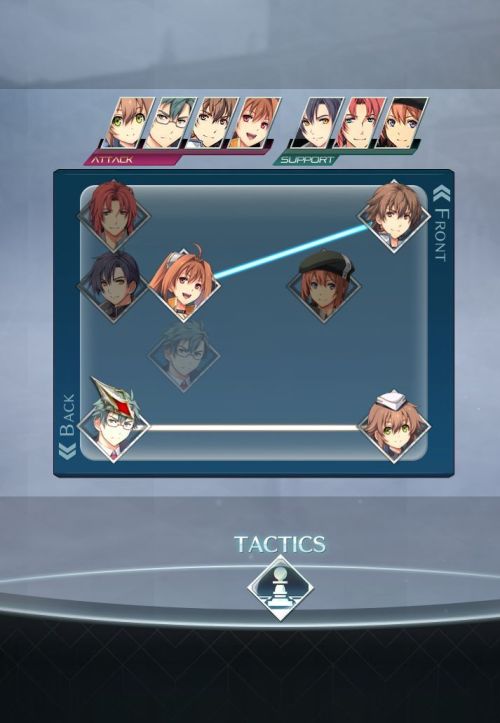
The Tactics tab will let you alter the formation of your party so that you can have your arts users in the back and tanks in front. Use this.
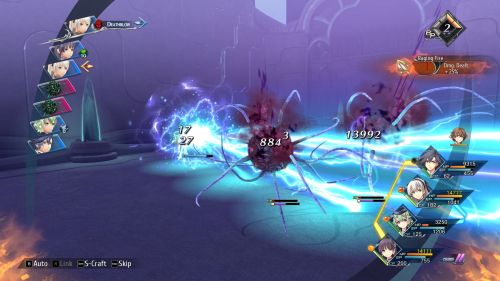
Destroying tentacle balls and big numbers. Name a better Japanese game combo.
There's a new Party menu which allows you to quickly browse through characters in each arc and change equipment. It is also used for some additional functions, like assigning Tagalongs, who give you additional Brave Order options.
The Reverie Corridor
Things open up the most around the end of Act II: after half a dozen hours of exploring, interaction with the locals and becoming re-acquainted with the world, you're thrown into the mega-dungeon, Reverie Corridor. This is in part a multi-tier dungeon similar to Phantasma from Trails in the Sky and Geofront from Crossbell – although you soon find out that it's much more than just a fighting space. It also serves as a hub and interaction point for quite a variety of cool things.
Let's dive a bit deeper into the Reverie Corridor itself. An important thing is that you can visit it as many times and as often as you like, gradually unlocking more levels and characters to play with in it, either through story progress or rewards. It presents you with missions of varying levels of rewards, ranging from clearing a section of enemies and optional missions that bring about small challenges. Interesting mechanics present themselves as you progress, as well as various combat curveballs – your dungeon party may, for example, activate a battle challenge for the reserve characters you've left behind.
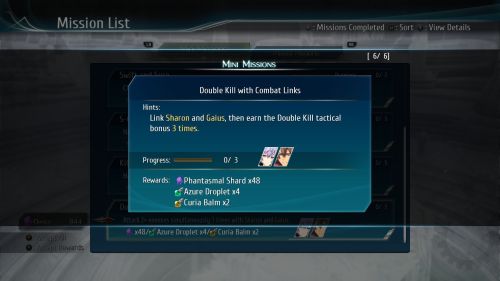
The Reverie Corridor presents you with various challenges that you can accomplish for rewards. Droplets are another way to stave off the grind, as they directly increase your stats and levels.
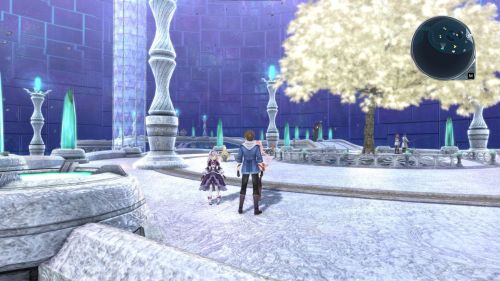
A magnificent place where you can go hang out and die with all your friends.
That's not to say it's perfect. The fact that you can visit it at any point in time is a double-edged sword, as you can use its healing functions to replenish all of your resources freely – and while that does take about a minute, it messes with things from a balance perspective.
What Else You Can Expect from Reverie
For those who have finished Trails of Cold Steel IV, upon starting Reverie, you may import your saves for some bonuses, as well as continuity in terms of the female companion you chose for Rean. A small, but neat addition.
The side systems flow in the same way they did in the Trails of Cold Steel entries: fishing earns you minor rewards, and you can also trade in your fish for consumables and upgrade materials. You can also cook, which nets you various meal consumables, which can actually be fairly handy – for example, feeding an entire area of people with an otherwise single-character meal, by taking advantage of the Moebius quartz, can change the outcome of a tough battle.
The music is top-notch, as always. Falcom has been reliably producing some of the best soundtracks in gaming ever since the early Ys. With Reverie, just as with Trails of Cold Steel, they employed their own in-house sound team, and still continue on with contracted composers such as Mitsuo Singa. The most impactful moments music-wise happen when the music changes after a couple of party members get knocked out in combat, going from energetic to ominous and threatening.
Incidentally, if you want to read more about Falcom's audio work, there's actually a surprising amount of drama surrounding them as a company and their audio work in the past few years. Here's an example, in case you're truly interested in a recent case.
Still, the important thing to take away is that the music is once again a masterful JRPG audio experience that is guaranteed to please you – no matter your specific tastes. It slows down and speeds up when it needs to and maintains and accompanies the game's pace, with familiar old melodies and cool new tracks.
The graphics are roughly the same as Trails of Cold Steel III and IV, with small upgrades to textures and the lighting system. The game shines in the diversity of environments you roam in more than its graphical fidelity: from Crossbell's oriental-inspired eastern district, to the claustrophobic dungeons under Heimdallr and the vast mountain fields of Nord. Simply taking in the scenery some times is enough to make you feel you are in it.
The attack, art and craft animations are the best-looking they've ever been, creating a lavish display of colors and anticipation for the end result of each action. You wanna feel cool, strong and powerful? Use any S-Craft.
In Reverie, like in any self-respecting Japanese game, there are various minigames you can play for rewards, from a card game, to a match-3, to a scrolling shooter. All of the minigames are quite well-developed, featuring integrations from the character cast in the voice, music and visual aspects. Each one introduces new simple but fun mechanics that make for a refreshing break from the main gameplay loop, and also give some ingame rewards. My personal favorite is the card game, Vantage Masters, which has been present in the series since Trails of Cold Steel III. Fun trivia: the Vantage Masters minigame is based on Falcom's short tactical-RPG series Vantage Master from 1997.
Cosmetics-wise, like any proper JRPG, there's the choice of getting some basic things like swimsuits through paid DLC and then unlocking additional outfits through playing. My impression is that outfit-wise, Reverie contains pretty much everything that's ever been in a past game. Unlocking things by playing feels quite a bit more satisfying and rewarding than just instantly having everything when you start the game, like in previous entries.
The Technical Details
Since this is about the western release of the game, we might as well discuss the localization. The series is extremely text-intensive, so this is actually a very big deal.
Reverie was released with a couple of instances of altered text and censored scenes; this happened because the localization studio, NISA, were either worried about a hypersensitive western audience or they simply did it via localizer fiat. Thankfully, previous games had certain fan-made patches that served to get around or completely undo censored pieces and I'm fairly hopeful they will pop up for Reverie as well. I don't want to dwell too much on this for this review, but let me say this as a personal editorial statement: if you're in the localization or translation business and you feel compelled to significantly alter or remove original material, shame on you.
The English text itself is quite competently written. There are no grammatical errors I have spotted, and only a couple of spelling and formatting mistakes – pretty impressive for a game of this size.
The purists will want to play with the Japanese voiceovers, which are, naturally, flawless. Japanese actors don't tend to view providing their voices for games as merely another job, but they pour their heart and soul into it – it's a cultural thing.
But due to the fact that Falcom's been going after the western market, you can tell they have invested in some pretty high-profile voiceacting in English too, and I have checked that out as well. Big names such as Matt Mercer and D.C. Douglas once again reprise roles for the English efforts – and, honestly, they're perfectly fine at what they do, despite often lacking the soul and gusto of their Japanese counterparts. While most of the voiceactor cast is quite professional, there are still a couple of distinct cases of, now repeated, poor quality English voiceacting I have noticed. As they drop the overall quality of the product unnecessarily, I will be calling them out specifically: Estelle's voiceactress desperately needs a technical upgrade and reporter Grace (voiced by some very unprofessional-sounding "non-binary" individual) simply needs to stop.
Regarding Reverie's PC port: Falcom and NISA, who also coordinated the PC port efforts, have officially once again let Durante handle things. Durante's the famous German PC port developer who rose to fame when he fixed, for free, the awful mess that the original Dark Souls was on PC. Those who have followed his work, including the founding of his own PC porting studio, know that the man has a strong passion for making awesome Japanese games accessible to all of us in the West at an excellent quality. With each recent Falcom port that he's been involved in, he has managed an extensive list of features and improvements, making sure that PC gamers get an experience that's massively superior to what both the consoles as well as the Japanese market originally got – and Reverie is the same, with a proper options menu with various adjustable settings.
Modern options that we're well used to by this point are officially present, like shadow resolution, draw distance and ambient occlusion. A nice feature that PC gamers have missed for a long time is the inclusion of MSAA, the old reliable form of anti-aliasing that has been lost to the ages in favor of blurrier, but faster solutions.
Resolutions above 1080p might hit your GPU hard – you'll be needing an RTX 3070 and over to maintain consistent high framerates walking around – that being said, I personally aim for 120 FPS for a game like this, not 60, so your mileage may vary if you're not too picky.
If you crank up the settings, there are certain spots that may drop your FPS slightly, like some environments on Mishelam beach and in the wilderness, but performance dips aren't something to be concerned about with Reverie. The last game in the series with large problematic areas in terms of performance was Trails of Cold Steel II.
What I personally would have liked to also see from the PC options is an internal resolution setting, essentially an ingame option to down/upscale on the render level.
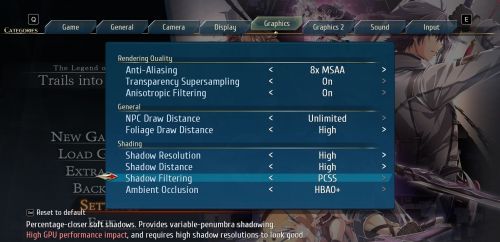
Durante has ensured there are plenty of settings to adjust, and, as a true enthusiast, has added extra technical context and warnings.
The High-Speed Mode (Turbo in other games) is a great timesaver in a massive game like this, allowing you to go through animations and travel faster. The function works wonderfully on PC, even when you push it up to 4x.
In addition, every cutscene, dialogue and every animation is simply skippable and able to be fast-forwarded with zero problems.
Closing Thoughts
Reverie is a gargantuan, over 100 hour-long JRPG experience primarily aimed at veterans of the series and a wrap-up to a long tale of hope and betrayal, as The Legend of Heroes prepares to move on to a new era.
The gameplay system is built upon a true and tried already existing formula and is the most fun it has ever been.
The story, once you get past some cheesy elements, is once again a mature political fable.
Massive in scope, Reverie sets out to highlight the events of major political turbulence of not just one, but multiple places across Zemuria, and it excels at doing just that without having individual characters and gameplay experiences take a backseat. As the flames of war in the continent are once again ignited, the player is called to take control of a vast number of individuals who have truly influenced the course of its history in the past, in tiny or larger ways; all in order to maintain a rickety peace through any means they consider necessary, regardless of if it is for the greater good or for an altogether different end goal...
It now falls on you, dear Codexer, to decide whether Trails into Reverie is worth your interest or not. To those of us already in love with the series, Reverie is one of the most important games made and exactly what we had been waiting for. If you're new to the franchise and think this could be a good first entry for you: while Reverie isn't as ideal a starting point for a newbie as Trails in the Sky, it's still vastly better than going in blind at some previous midpoint, so, in the end, not a bad choice if you're on a limited budget.
Regardless, Falcom has yet to let fans down, putting out masterpieces again and again – and Trails into Reverie is yet another.
– – –
Extra Screens:
The Legend of Heroes: Trails into Reverie
The Legend of Heroes
It's no secret that there has been a dearth of JRPG coverage here since Crooked Bee and other old contributors stepped away.
Despite a small percentage of the RPG population thinking of Japanese RPGs as an exotic genre, JRPGs have played a formative role in the growing – up process of millions of gamers in the west: from each lengthy Final Fantasy experience, to the colorful Breath of Fire, to the wackiness of Earthbound, to the dungeons of Shining Force or to the collectathons of Pokémon (also, did you know that one of the earliest pieces of Codex content was about Grandia II?).
And what about The Legend of Heroes? Although not too many are aware these days, The Legend of Heroes, by Falcom (the company behind these games, and also behind The Legendary Ys) had its start all the way back in 1989 – it was a series of games very different to the ones of today, though. Its reinvention with 2004's The Legend of Heroes: Trails in the Sky made Falcom wildly popular in both Japan and the West. These games are so well-respected and adored on our side of the globe that people translate them for free before they receive official western releases, just so the community may get to enjoy them.
And there's much to love, starting with the games' setting. While older Japanese game series in a shared universe do exist, (such as Metal Gear) The Legend of Heroes, now officially running for 19 years, is set to make a record for the longest running one in a consistent, well – defined original setting; the world of Zemuria.
This review focuses on the latest western PC release of Trails into Reverie, part of the modern The Legend of Heroes.
The Past and the Present
Let's start off with the basics. The Legend of Heroes series is divided into five categories/settings, in order of release:
- Trails in the Sky (3 games)
- Crossbell (2 games)
- Trails of Cold Steel (4 games)
- Trails into Reverie (the subject of this review – will be referred to as Reverie from now on) (1 game)
- [Kuro no Kiseki/Calvard – unknown western title as of yet] (2 games yet to be released in the west)
Reverie itself is a special release that serves as the end of an era, intended to bridge the gap between the past and future. For all intents and purposes, many, including myself, consider it to be a continuation of Trails of Cold Steel, as it looks and sounds the same, technically being the fifth game in the series.
The Setting
The world of The Legend of Heroes games is one where traditional fantasy and science-fiction have married and live happily together. There is no significant struggle of magic versus technology, like in other similar settings. In Zemuria, the usage of both is something that's considered quite ordinary; the populace at-large and common people have adapted to the ancient arcane arts, as well as the developments of the Orbal Revolution, one of the most defining historical events of the setting.
While Trails in the Sky was a bit more steampunk-ish, Cold Steel pushed the environment towards a more soft fantasy tone, with a remaining base of industry, religion and magic.
Despite all that, the series' main draw is undoubtedly politics, and there are very few original settings with the level of political lore and development comparable to it.
The Legend of Heroes, if you boil it down, is a very long political soap opera in an essence of fantasy.
There's an aspect of ever-looming war with mech/action elements, especially during battle, and it all serves to reinforce the base setting and plotlines. The writers of the series have obviously taken inspiration from major western historical conflicts like the European wars of succession, the Napoleonic wars and the American Revolutionary War. The underlying themes of Empires and Kingdoms, annexations, civil war and independence have been a focal point since the beginning. These matters continue to be just as important with Reverie, the events of the independence of the Crossbell State bringing together motley groups of mages, soldiers, students, politicians and divinely blessed heroes.

Map of Zemuria. Reverie's events play around a developing situation in Crossbell and the tensions it creates as an important center point stuck between the neighboring nations of the Erebonian Empire and the Calvard Republic. (courtesy of Kiseki Wikia)
Immersion
Since Trails in the Sky came out, the series' strongest point has always been its capability for immersion in the world. The reviews of the series starting in 2004 have traditionally mentioned the astonishing attention to detail, with reviewers being impressed by the fact that each character had their own name, background origins, personality and aspirations, rather than just being "NPC #12" and "Character #24". These games truly feel alive, in ways that no other series ever has. The world of Zemuria itself never just displays happiness incarnate, but it's never pure gloom either. It's a balanced, objective world that is realistic and alive, in every meaning of the word, where every non-player character feels important and worth your time learning about and talking to. No other series has been able to achieve this level of fleshing out for its setting. And the great thing is that as events are always on the move and organic, the player is always kept on his toes. If you're a series veteran, get ready for the twists and turns of Reverie, where certain parts are once again turned on their heads!
While the games don't often break the fourth wall and dialogue doesn't tend to be 'gamey', some characters do say things like 'leveled up' and derivatives from time to time. It's not really a big deal, and you can consider that one of the few occurences of the game not achieving perfect in-setting immersion.
Here's another slightly more meta/background point that I often am critical of as I play narrative-heavy games: The series does well with not creating any dissonance between what the characters do during active gameplay and what they actually say and claim in cutscenes and dialogue – a disconnect that happens in various games quite often, especially of the more freeform kind. That's not to say there's branching dialogue or reactivity in cutscenes, because there isn't, but rather that the narration remains consistent with who the characters are.
Don't come to these games expecting to find Dark Souls. You are not an unnamed creature roaming the lands. You are always some form of an important character, with an existing place in the world. The mix of text, roaming and combat has been one quite specific to The Legend of Heroes series, and one they've set themselves a reliable formula for. Expect to read a lot of text, go through sequences of cutscenes and then maybe hours of long successive combat encounters or a half-hour long boss battle.
These games always call on you to be someone who makes an impact – although this is done in a more grounded rather than the Marvel superhero sense of the word. And while your characters play important roles, you're never the biggest fish in the pond in these games – just the way it should be in every self-respecting piece of fiction that showcases conflict.
Reverie
Trails into Reverie came out in Japan in 2020, but the proper western PC port was released only in early July 2023. As it stands, it's a brand new experience for most of us.
Before we get into the nitty-gritty, I want to get this out of the way and address the matters of balance briefly: there's a... good reason behind the stereotype that the Japanese don't know how to balance games and this franchise reinforces that notion, at times. The Legend of Heroes games have never been particularly difficult, with the exception of Trails in the Sky 3rd, which has been known to be a pain in the rear at times. The first Cold Steel could also be decently challenging occasionally at high difficulties, but only if you compare it with the sequels, which ended up being quite forgiving. These games will not always provide a hardcore combat experience unless you push them to the absolute highest difficulties – and that might occasionally rob you of the joy of experimentation they offer. I'll be providing some more input on this further on.
Trails of Cold Steel, which Reverie is built on, has been traditionally viewed as a relatively easy series when it comes to combat; and that was not because the monsters didn't hit hard enough or because of overwhelmingly powerful player character abilities, but rather due to the gradual introduction of more and more combat tools, such as Brave Orders, power-creep equipment upgrades, dual quartz etc. Cold Steel IV turned out to be the easiest game in the whole franchise due to just how many options and characters they ended up making available to the player, and Falcom not having balanced appropriately around those at even the highest difficulties. In the case of this series, continuously opening up new options for the player made combat significantly easier!
But read on to know more about the improvements Reverie has made in this regard, because they are thankfully present...
Let's get one thing out of the way for those who have played games in the series previously: Trails into Reverie does not reinvent the wheel – but it does do a whole bunch of things better than its predecessors.
What can Reverie provide to a series veteran and can it be a good starting point for a newcomer?
- A comprehensive experience that includes a vast amount of elements from all past games.
- A combat experience that's more suitable for those desiring a challenge (at higher difficulties), with tasteful improvements to the Trails of Cold Steel battle system across the board.
- Due to the most expansive character cast and different environments to date, it serves as an all-inclusive view into the series.

The game is a farewell ode to many of the heroes we've come to know and love over the past two decades.
The game itself is split into 3 arcs, each one centered on different protagonists and their respective groups.
- Crossbell's Lloyd
- Erebonia's Rean
- The mysterious C
Out of the three main characters:
- There's little doubt that C has a very strong opening as the most interesting character in Reverie. There isn't much I can reveal without spoiling things in a major way, but a main character with gray, unclear motives has been sorely lacking in the series. The possibilities C presents and opens up are entirely novel here. Imagine him as more of a... Neutral Evil character, if you wish to think in terms of alignment, although both himself and others close to him end up finding out there's more than meets the eye.
- Rean comes in second place. Rean's development throughout Trails of Cold Steel makes him the most fleshed-out main character in the franchise. His journey from teenager with a hero complex to tormented swordsman battling inner demons and heavy burdens still has more to give.
- Lloyd from the Crossbell games was never too intriguing as a character per se, being cheesy and single-purpose driven as they come, yet that doesn't detract from his charm. Lloyd is a simple-minded good guy, and he generally tends to give you exactly what you expect as you play his arc. He gives you a nice sense of self-righteousness as you control him.

C is edgy.

I'll take your mind off disastrous politics and a bad economy by introducing you to them in a new setting.
Rean and Lloyd both have their fans and detractors online. Considering the franchise started with old favorite Estelle throughout the 3 Trails in the Sky games, continued on with Lloyd through 2 Crossbell games and then Rean with the 4 Trails of Cold Steel games, it's fairly obvious that Rean has ended up receiving the most character development.
That being said, there's an important point that needs to be made. These games were never about the main characters, and anyone who tells you they are is simply wrong, ill-informed or a liar. Each one of the MCs has remained heavily grounded throughout the franchise and is only slightly relevant when it comes to the true grand tales: the one of the land, the one of bonds being forged, the one of the past influencing a future. The importance of each arc is highlighted via every controlled character and their presented struggles against a shared goal, while the MC leads the way forward and serves as a central point to bring all those different personalities together.
In Reverie, you will go from saving children to preventing apocalypses. Don't expect to find something grimdark like in King Arthur: Knight's Tale here. This is a colorful game, although not necessarily too cheery once you begin exploring what truly lies under the surface. The foes that await you are once again countless and, thankfully, memorable. You'll see the return of old villains and meet new ones.
Like every game throughout this franchise, the focus isn't simply on the heroics and the grand achievements. There are many day-to-day life and behind-the-scenes elements spread throughout, the spotlight occasionally shining on activities that highlight the massive effort behind the annexation of a country or the desires of the common soldier. The action and core tension is maintained by those critical principles being present, like in any good, long drama series.
As in many anime and JRPGs, Reverie has its ups and downs and there are even some deus-ex-machina moments that might make you question matters; I do too, occasionally. Regardless, the instances are not too many and the story remains for the most part fairly grounded, as it should be.
The game is different from other previous core entries in the sense that tension is maintained throughout the whole deal. Mostly everything that happens is linked to the main plot and conflict, meaning that familiar past "slice-of-life" content is limited, and largely only accessible through the Reverie Corridor.
The Core of Reverie
Once again you will get to control a massive cast of characters, each one with their own personality and combat abilities. You'll meet old characters and new alike – among them, the protagonists of every past series, a political terrorist leader, a powerful villain re-emerged and even a sentient doll. The characters whose lives you will closely experience constantly struggle with their own morality and place in the world, such as the former contract killer Rixia when she encounters a duo of young assassins, and Rean, when he meets a master of both the blade and life that far surpasses his own abilities.
The characters come and go throughout the game, much like in previous entries. Don't get too attached to anyone for too long and try not to equip your absolute strongest equipment or gems on anyone but the main characters until you have plenty enough to go around; the way the game flows is entirely dependent on the plot.
And the enemies do include just everything this time as well, from dancing ant-eaters to krakens and demons, assassins, perverted versions of your own characters and more. Some of the creatures are throwbacks to Trails in the Sky from 19 years ago, others are brand new. Regardless, figuring out and exploiting or working around weaknesses and resistances is as fun as ever, especially when you introduce the high difficulty tactical element.
Combat itself consists of a turn-based JRPG system reminiscent of older Final Fantasy games, with a focus on extravagant, cool visual effects.
Once again, using an S-Craft which allows you to turn the tide of battle and annihilate your enemies is an incomparable power trip. Pathfinder can't do this.
That being said, it's important to highlight the following: once you start the game, choose Nightmare difficulty and never go below it. All points in this review assume Nightmare difficulty and above. Would it have been nice for Normal difficulty to be more appropriate? Yeah – but this is a Japanese game! The high difficulties are still not perfect, especially when it comes to... you guessed it, the bosses! Expect to get absolutely pounded by certain big bosses damage-wise, who will also often hijack your actions (much like the player can do with S-Crafts, heh). But who doesn't like a bit of challenge every now and then?
You can also go for Abyss, but then you'll be starting to move into absolute build optimization territory and maybe even be forced to grind; if that's what you're into, go for it. Abyss is probably decent for a New Game+ run, providing a challenge that we haven't seen in the franchise in a very long time.
Once again, taking heed of your enemies' strength and weaknesses by examining their stats is vital to quick and painless victories.
Reverie utilizes all the new tools you have in your arsenal to a satisfying extent, granting you unparalleled freedom in how you want to achieve victory in battle. Equipping your characters with different setups is a joy – with access to the most quartz the series has ever provided, the tactical choices open up vastly, allowing you to try anything from pure magic to full evasion on any one character.
Itemization is a multi-pronged deal and mostly dependent on what stats you're aiming for.
The character combinations and party mix-ups you can try allow for quite a bit of experimentation. This all comes together in ideal fashion in the Reverie Corridor (more on this later).
You can, as in many modern JRPGs, approach the enemy on the field and strike them from the back to make the initial leg of your fight easier, or link up multiple groups of enemies together to fight them in a chain battle for bigger rewards. You may also consume an Assault Gauge charge to stun your enemy on the field and gain what is called a Triple Advantage, which makes it easier to break them when the fight starts. In the same manner, if you fail to dodge your enemy while running around on the field and they attack you from the back, they'll gain the advantage on you, as well as scramble your formation and Combat Links. The whole system also serves to keep the grinding at bay, as it allows you to instantly destroy enemies you massively outlevel without wasting time fighting them, while still getting the rewards.
Those aformentioned systems were already fully present in the latter two of past Trails of Cold Steel games, but there's now a new additional, in-battle use for the Assault Gauge: an action called United Front, which presents three additional choices.
- UF Attack
- UF Arts
- UF Heal
Seeing as Reverie promotes characters to some very high levels, expect to see quartz and stat upgrades quite early; for example, Rean's starting Brigid, providing you massive amounts of CP (Craft Points) regeneration, or the Titania quartz, which actually gives you EP (Energy Points) when you use arts so you can use MORE arts. Of course, you can swap around most of those between characters – even between arcs after you've progressed a while. For those who can't handle the feeling of weakness their characters are infected with after starting a sequel, I can safely say you won't have to suffer for more than maybe 10-15 levels – and thankfully, you get to see a whole bunch of new abilities as well, so it's not just about striving to get to your previous Trails of Cold Steel IV power levels.
Reverie once again utilizes the Action Time Battle system that's been in use since Trails in the Sky. The most important, by far, tactical aspect of higher-difficulty combat is the battle/action order (call it initiative or whatever you want, it's similar enough). Some turns will elicit special effects, giving you instant-cast magic arts or letting you inflict a guaranteed status effect etc or even having a negative effect, like draining your EP. Watch that action bar like a hawk, and as competitive gamers say, PRAY FOR CRITS (and be sure to steal your opponents' criticals with S-Crafts).
Given that we play on Nightmare and above, positioning is a much more serious matter. Regardless of how hard your characters may hit, the enemies will usually hit harder on Nightmare and over. You need to spread out enough to avoid AOE abilities, but not too much so that you cannot AOE heal your people, if possible.

The Tactics tab will let you alter the formation of your party so that you can have your arts users in the back and tanks in front. Use this.

Destroying tentacle balls and big numbers. Name a better Japanese game combo.
There's a new Party menu which allows you to quickly browse through characters in each arc and change equipment. It is also used for some additional functions, like assigning Tagalongs, who give you additional Brave Order options.
The Reverie Corridor
Things open up the most around the end of Act II: after half a dozen hours of exploring, interaction with the locals and becoming re-acquainted with the world, you're thrown into the mega-dungeon, Reverie Corridor. This is in part a multi-tier dungeon similar to Phantasma from Trails in the Sky and Geofront from Crossbell – although you soon find out that it's much more than just a fighting space. It also serves as a hub and interaction point for quite a variety of cool things.
Let's dive a bit deeper into the Reverie Corridor itself. An important thing is that you can visit it as many times and as often as you like, gradually unlocking more levels and characters to play with in it, either through story progress or rewards. It presents you with missions of varying levels of rewards, ranging from clearing a section of enemies and optional missions that bring about small challenges. Interesting mechanics present themselves as you progress, as well as various combat curveballs – your dungeon party may, for example, activate a battle challenge for the reserve characters you've left behind.

The Reverie Corridor presents you with various challenges that you can accomplish for rewards. Droplets are another way to stave off the grind, as they directly increase your stats and levels.

A magnificent place where you can go hang out and die with all your friends.
That's not to say it's perfect. The fact that you can visit it at any point in time is a double-edged sword, as you can use its healing functions to replenish all of your resources freely – and while that does take about a minute, it messes with things from a balance perspective.
What Else You Can Expect from Reverie
For those who have finished Trails of Cold Steel IV, upon starting Reverie, you may import your saves for some bonuses, as well as continuity in terms of the female companion you chose for Rean. A small, but neat addition.
The side systems flow in the same way they did in the Trails of Cold Steel entries: fishing earns you minor rewards, and you can also trade in your fish for consumables and upgrade materials. You can also cook, which nets you various meal consumables, which can actually be fairly handy – for example, feeding an entire area of people with an otherwise single-character meal, by taking advantage of the Moebius quartz, can change the outcome of a tough battle.
The music is top-notch, as always. Falcom has been reliably producing some of the best soundtracks in gaming ever since the early Ys. With Reverie, just as with Trails of Cold Steel, they employed their own in-house sound team, and still continue on with contracted composers such as Mitsuo Singa. The most impactful moments music-wise happen when the music changes after a couple of party members get knocked out in combat, going from energetic to ominous and threatening.
Incidentally, if you want to read more about Falcom's audio work, there's actually a surprising amount of drama surrounding them as a company and their audio work in the past few years. Here's an example, in case you're truly interested in a recent case.
Still, the important thing to take away is that the music is once again a masterful JRPG audio experience that is guaranteed to please you – no matter your specific tastes. It slows down and speeds up when it needs to and maintains and accompanies the game's pace, with familiar old melodies and cool new tracks.
The graphics are roughly the same as Trails of Cold Steel III and IV, with small upgrades to textures and the lighting system. The game shines in the diversity of environments you roam in more than its graphical fidelity: from Crossbell's oriental-inspired eastern district, to the claustrophobic dungeons under Heimdallr and the vast mountain fields of Nord. Simply taking in the scenery some times is enough to make you feel you are in it.
The attack, art and craft animations are the best-looking they've ever been, creating a lavish display of colors and anticipation for the end result of each action. You wanna feel cool, strong and powerful? Use any S-Craft.
In Reverie, like in any self-respecting Japanese game, there are various minigames you can play for rewards, from a card game, to a match-3, to a scrolling shooter. All of the minigames are quite well-developed, featuring integrations from the character cast in the voice, music and visual aspects. Each one introduces new simple but fun mechanics that make for a refreshing break from the main gameplay loop, and also give some ingame rewards. My personal favorite is the card game, Vantage Masters, which has been present in the series since Trails of Cold Steel III. Fun trivia: the Vantage Masters minigame is based on Falcom's short tactical-RPG series Vantage Master from 1997.
Cosmetics-wise, like any proper JRPG, there's the choice of getting some basic things like swimsuits through paid DLC and then unlocking additional outfits through playing. My impression is that outfit-wise, Reverie contains pretty much everything that's ever been in a past game. Unlocking things by playing feels quite a bit more satisfying and rewarding than just instantly having everything when you start the game, like in previous entries.
The Technical Details
Since this is about the western release of the game, we might as well discuss the localization. The series is extremely text-intensive, so this is actually a very big deal.
Reverie was released with a couple of instances of altered text and censored scenes; this happened because the localization studio, NISA, were either worried about a hypersensitive western audience or they simply did it via localizer fiat. Thankfully, previous games had certain fan-made patches that served to get around or completely undo censored pieces and I'm fairly hopeful they will pop up for Reverie as well. I don't want to dwell too much on this for this review, but let me say this as a personal editorial statement: if you're in the localization or translation business and you feel compelled to significantly alter or remove original material, shame on you.
The English text itself is quite competently written. There are no grammatical errors I have spotted, and only a couple of spelling and formatting mistakes – pretty impressive for a game of this size.
The purists will want to play with the Japanese voiceovers, which are, naturally, flawless. Japanese actors don't tend to view providing their voices for games as merely another job, but they pour their heart and soul into it – it's a cultural thing.
But due to the fact that Falcom's been going after the western market, you can tell they have invested in some pretty high-profile voiceacting in English too, and I have checked that out as well. Big names such as Matt Mercer and D.C. Douglas once again reprise roles for the English efforts – and, honestly, they're perfectly fine at what they do, despite often lacking the soul and gusto of their Japanese counterparts. While most of the voiceactor cast is quite professional, there are still a couple of distinct cases of, now repeated, poor quality English voiceacting I have noticed. As they drop the overall quality of the product unnecessarily, I will be calling them out specifically: Estelle's voiceactress desperately needs a technical upgrade and reporter Grace (voiced by some very unprofessional-sounding "non-binary" individual) simply needs to stop.
Regarding Reverie's PC port: Falcom and NISA, who also coordinated the PC port efforts, have officially once again let Durante handle things. Durante's the famous German PC port developer who rose to fame when he fixed, for free, the awful mess that the original Dark Souls was on PC. Those who have followed his work, including the founding of his own PC porting studio, know that the man has a strong passion for making awesome Japanese games accessible to all of us in the West at an excellent quality. With each recent Falcom port that he's been involved in, he has managed an extensive list of features and improvements, making sure that PC gamers get an experience that's massively superior to what both the consoles as well as the Japanese market originally got – and Reverie is the same, with a proper options menu with various adjustable settings.
Modern options that we're well used to by this point are officially present, like shadow resolution, draw distance and ambient occlusion. A nice feature that PC gamers have missed for a long time is the inclusion of MSAA, the old reliable form of anti-aliasing that has been lost to the ages in favor of blurrier, but faster solutions.
Resolutions above 1080p might hit your GPU hard – you'll be needing an RTX 3070 and over to maintain consistent high framerates walking around – that being said, I personally aim for 120 FPS for a game like this, not 60, so your mileage may vary if you're not too picky.
If you crank up the settings, there are certain spots that may drop your FPS slightly, like some environments on Mishelam beach and in the wilderness, but performance dips aren't something to be concerned about with Reverie. The last game in the series with large problematic areas in terms of performance was Trails of Cold Steel II.
What I personally would have liked to also see from the PC options is an internal resolution setting, essentially an ingame option to down/upscale on the render level.

Durante has ensured there are plenty of settings to adjust, and, as a true enthusiast, has added extra technical context and warnings.
The High-Speed Mode (Turbo in other games) is a great timesaver in a massive game like this, allowing you to go through animations and travel faster. The function works wonderfully on PC, even when you push it up to 4x.
In addition, every cutscene, dialogue and every animation is simply skippable and able to be fast-forwarded with zero problems.
Closing Thoughts
Reverie is a gargantuan, over 100 hour-long JRPG experience primarily aimed at veterans of the series and a wrap-up to a long tale of hope and betrayal, as The Legend of Heroes prepares to move on to a new era.
The gameplay system is built upon a true and tried already existing formula and is the most fun it has ever been.
The story, once you get past some cheesy elements, is once again a mature political fable.
Massive in scope, Reverie sets out to highlight the events of major political turbulence of not just one, but multiple places across Zemuria, and it excels at doing just that without having individual characters and gameplay experiences take a backseat. As the flames of war in the continent are once again ignited, the player is called to take control of a vast number of individuals who have truly influenced the course of its history in the past, in tiny or larger ways; all in order to maintain a rickety peace through any means they consider necessary, regardless of if it is for the greater good or for an altogether different end goal...
It now falls on you, dear Codexer, to decide whether Trails into Reverie is worth your interest or not. To those of us already in love with the series, Reverie is one of the most important games made and exactly what we had been waiting for. If you're new to the franchise and think this could be a good first entry for you: while Reverie isn't as ideal a starting point for a newbie as Trails in the Sky, it's still vastly better than going in blind at some previous midpoint, so, in the end, not a bad choice if you're on a limited budget.
Regardless, Falcom has yet to let fans down, putting out masterpieces again and again – and Trails into Reverie is yet another.
– – –
Extra Screens:
There are 113 comments on JRPG Codex Review: The Legend of Heroes: Trails into Reverie





